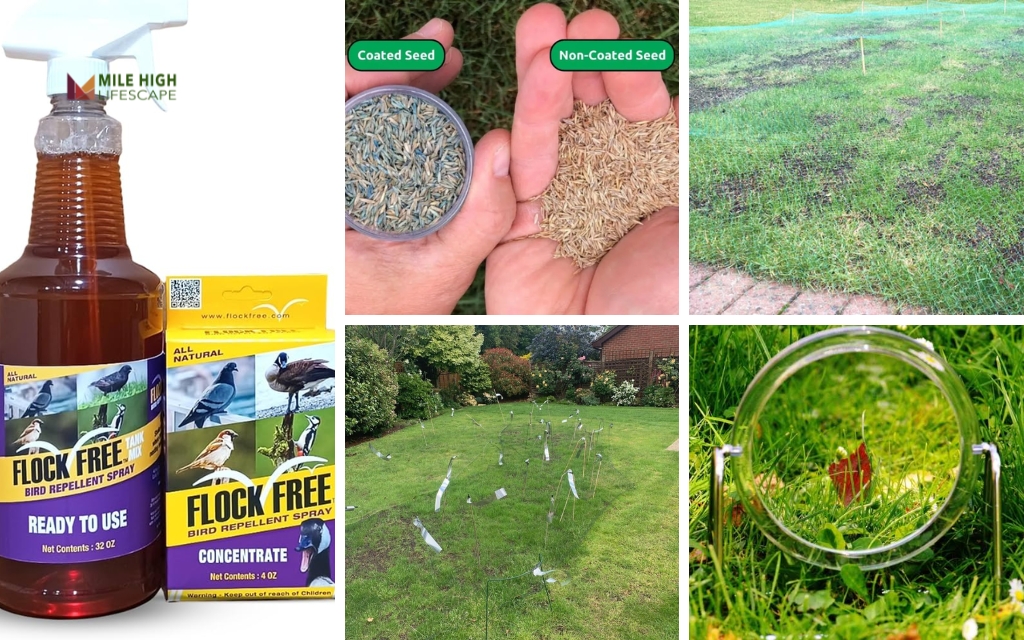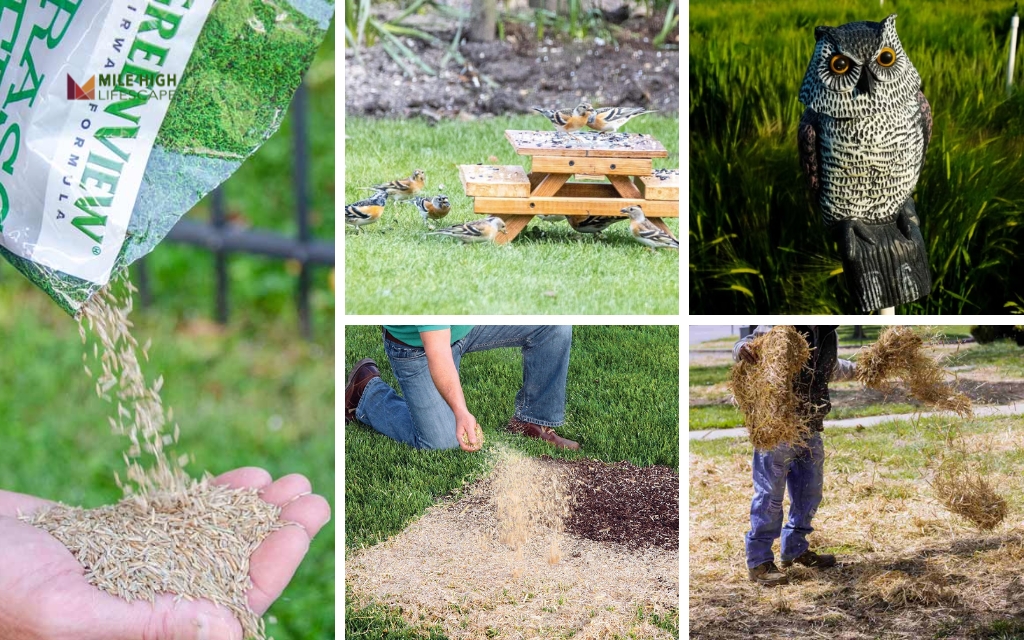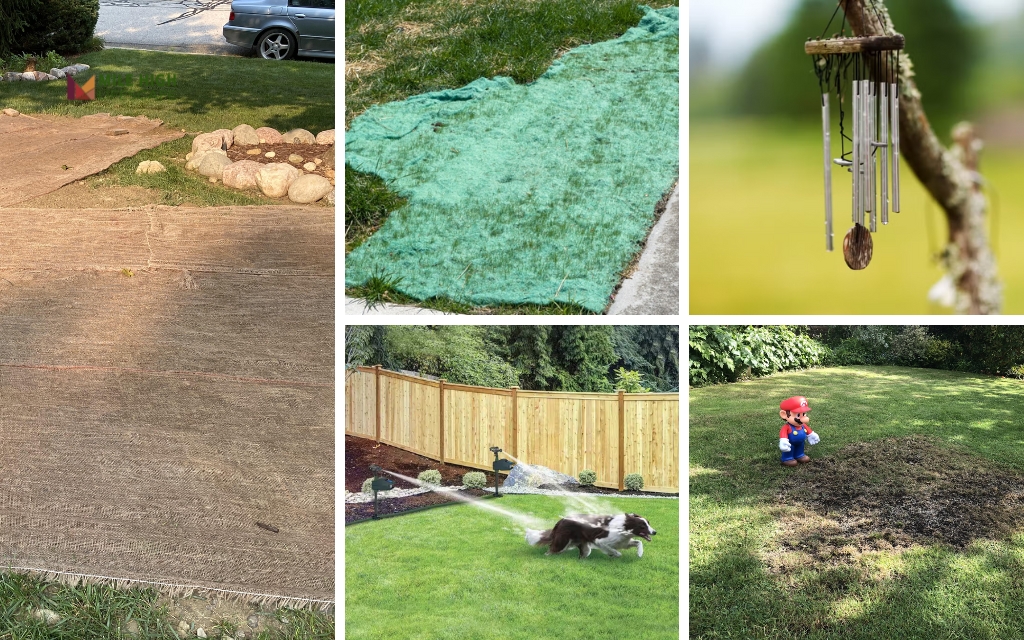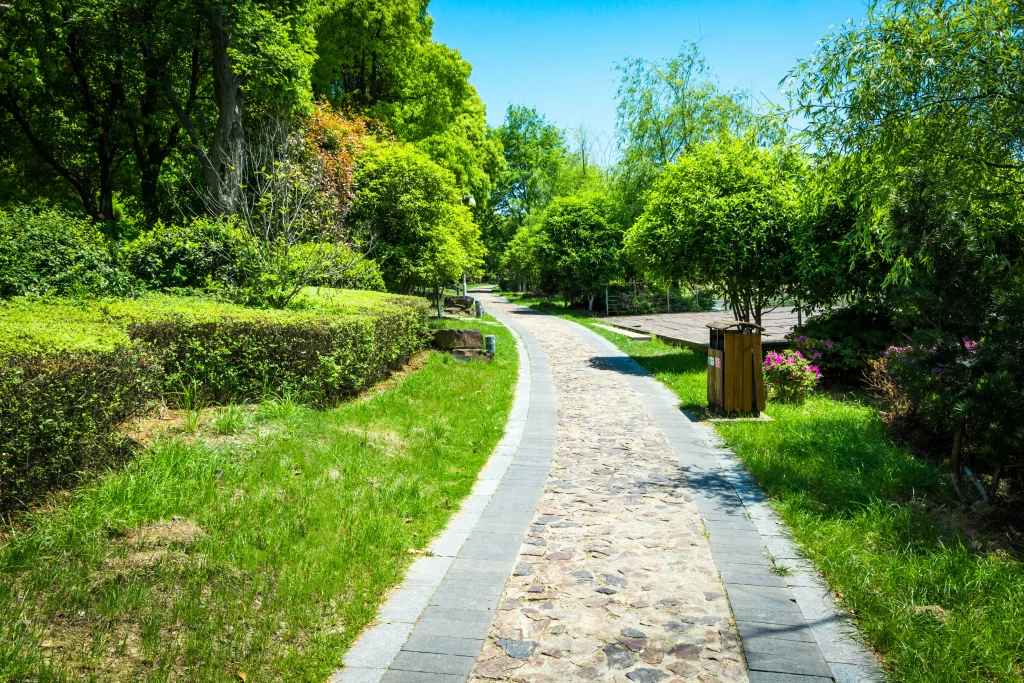You’ve just spent hours preparing your lawn—raking, spreading seed, and watering with care—only to discover bare patches weeks later where birds have feasted on your hard work. This common frustration affects countless homeowners in Denver and beyond who watch their landscaping investment literally fly away in the beaks of sparrows, robins, and finches.
Birds naturally gravitate toward freshly seeded lawns because they offer an easy meal. The exposed seeds create a buffet-like situation, particularly attractive to ground-feeding species like sparrows, robins, and pigeons that instinctively search for food in open areas. The nutritional value of grass seed provides birds with essential energy, making your new lawn project particularly vulnerable.
In this guide, you’ll discover 20+ proven, humane methods to protect your grass seed investment. These techniques range from simple DIY solutions to professional-grade approaches that work effectively in Denver’s unique climate. With these strategies, you can establish a lush lawn while coexisting peacefully with local wildlife.
1. Use Bird Repellent
Bird repellents create sensory barriers that discourage birds from landing on your newly seeded lawn. Commercial repellents come in liquid sprays or granular forms containing natural ingredients like methyl anthranilate (derived from grapes) or garlic oil. Apply these products according to package directions, creating a perimeter around the seeded area. Most repellents require reapplication after rain or every 7-10 days until germination occurs.
Choose EPA-registered products for safety around pets and children.
2. Choose Bird-Repellent Grass Seed Varieties
Specialized grass seed varieties feature protective coatings that deter birds while enhancing germination. These seeds contain non-toxic compounds that create unpleasant tastes for birds without affecting growth performance. Coated seeds often contain anthraquinone, which causes digestive discomfort in birds but doesn’t harm them permanently. These seeds typically cost more than standard varieties but reduce overall loss and replacement expenses.
Ask local garden centers for coated seed options suitable for Denver’s climate.
3. Use Bird Netting
Bird netting creates a physical barrier between birds and your grass seed. Install netting 1-2 inches above the soil surface, securing it with landscape pins or stakes around the perimeter. Select netting with 1/2-inch or smaller mesh size to prevent even small birds from accessing seeds. Remove the netting once seedlings reach 2-3 inches in height to prevent growth interference.
Installation Tips:
- Stake corners first, then add stakes every 3-4 feet
- Leave 1-2 inches of slack for seedling growth
- Check daily for proper tension and bird-free spaces
4. Hang CDs or Aluminum Foil
Reflective objects create unpredictable light patterns that confuse and deter birds. String old CDs or aluminum foil strips on fishing line or thin wire, then suspend them 1-3 feet above seeded areas. Space reflectors 3-5 feet apart, allowing them to twist and turn in the breeze. The constantly changing light patterns disrupt birds’ ability to focus on finding seeds.
This method works best on sunny days when light reflection maximizes effectiveness.
5. Use Reflective Objects
Beyond CDs, other reflective deterrents include reflective bird tape, garden spinners, and metallic pinwheels. Position these items throughout the newly seeded area, focusing on the perimeter and central sections. Reflective bird tape creates noise and light reflections when moved by wind, adding dual sensory deterrents. Garden spinners with reflective surfaces create movement patterns that birds perceive as potential danger, triggering their natural avoidance instincts.

6. Select the Right Grass Seed
Fast-germinating grass varieties reduce the window of vulnerability to bird predation. Kentucky bluegrass takes 14-30 days to germinate, while perennial ryegrass emerges in just 5-10 days. For Denver lawns, consider drought-resistant fescue blends with quick-establishing nurse grasses like ryegrass. These blends establish ground cover faster, limiting birds’ access to seeds.
The reduced exposure time significantly decreases seed loss while promoting consistent lawn establishment.
For Denver lawns, selecting the right grass seed is crucial. Kentucky bluegrass is a popular choice, but how does it compare to other options? If you’re weighing your options, our article on Which is Better: Kentucky Bluegrass or Tall Fescue? offers a detailed comparison to help you decide.
7. Offer Alternative Food Sources
Strategic distraction feeding redirects birds away from your grass seed. Place bird feeders 15-20 feet away from seeded areas, filling them with high-energy seeds like sunflower, millet, or nyjer. This creates a more attractive feeding station than your scattered grass seed. Maintain consistent food supply during the critical germination period to keep birds returning to the feeders rather than searching your lawn.
This method transforms potential lawn destroyers into garden visitors.
8. Use Fake Owls or Hawks
Predator decoys exploit birds’ natural fear response. Place realistic owl or hawk models near seeded areas, ensuring they’re visible from multiple angles. Mount decoys on poles or fence posts at least 3 feet above ground for maximum visibility. The critical factor for effectiveness is regular movement—stationary decoys quickly lose effectiveness as birds recognize the lack of threat. Relocate decoys every 2-3 days and consider models with movable wings or solar-powered motion features.
9. Apply Mulch Over the Seeds
A thin mulch layer protects seeds while maintaining essential moisture. Apply 1/8 to 1/4 inch of mulch directly over seeded areas, creating a protective barrier without preventing germination. Effective mulch options include:
- Compost: Enhances soil while protecting seeds
- Peat moss: Holds moisture effectively in Denver’s dry climate
- Straw: Lightweight with good seed visibility protection
The mulch barrier physically blocks birds from seeing seeds while promoting faster germination by maintaining soil temperature and moisture levels.
Mile High Lifescape brings over 20+ years of Denver landscaping expertise to your property, delivering mulch installation services that respect Colorado’s unique environmental conditions. While DIY mulching might seem straightforward, professional installation ensures you receive the full spectrum of benefits that proper mulching provides to your Colorado landscape.
10. Use Straw or Mulch Covers
Straw provides affordable, effective seed protection when applied correctly. Spread a thin layer of weed-free straw (approximately one bale per 1,000 square feet) over newly seeded areas. The straw should cover about 50% of the soil surface—enough to hide seeds without smothering germination. In Denver’s windy conditions, lightly water the straw to prevent displacement. Remove excess straw once seedlings reach 2 inches high to prevent competition for light and nutrients.

11. Cover the Seeds with Burlap Sheets
Burlap creates a breathable protective layer that blocks bird access while allowing seedlings to emerge. Lay burlap sheets directly over seeded areas, securing edges with landscape staples or heavy objects. The material’s porous nature allows water and air exchange while filtering sunlight appropriately for germination. Remove burlap gradually once you observe consistent germination, starting with daytime removal and eventually removing completely when seedlings reach 1-2 inches.
12. Try Grass Seed Mats
Pre-made seed mats combine seeds, mulch, and biodegradable materials for comprehensive protection. These mats provide uniform seed distribution and built-in bird protection while maintaining moisture levels. Installation requires simply unrolling the mats over prepared soil and watering thoroughly. The mats dissolve naturally as seeds germinate, eliminating removal requirements. These products prove particularly effective on slopes and areas with erosion concerns in Denver’s variable precipitation patterns.
13. Install Wind Chimes
Wind chimes create unpredictable noise patterns that disrupt birds’ feeding comfort. Install several sets of metal wind chimes around the seeded area’s perimeter, positioning them at different heights. Birds remain cautious around unpredictable, intermittent sounds that signal potential danger. Metal chimes produce sharper, more effective deterrent sounds than bamboo or wood alternatives.
This method works particularly well when combined with visual deterrents for multi-sensory protection.
14. Set Up Motion-Activated Sprinklers
Motion-activated sprinklers deliver sudden water bursts when detecting movement, creating effective bird deterrence. Position these devices on the perimeter of seeded areas, adjusting sensitivity settings to trigger for bird-sized creatures. The combination of sudden movement, water spray, and noise creates a multi-sensory deterrent without causing harm. These systems conserve water by activating only when needed, making them suitable for Denver’s water-conscious landscaping practices.
15. Use Scarecrows
Modern scarecrows combine traditional design with movement enhancements for increased effectiveness. Construct a basic frame using old clothes stuffed with straw or garden refuse, adding reflective materials like aluminum strips or old CDs for movement and light reflection. Position scarecrows centrally in seeded areas, ensuring they stand at least 4-5 feet tall. Enhance effectiveness by:
- Adding loose-fitting clothing that moves in the wind
- Incorporating reflective elements that catch sunlight
- Repositioning every 2-3 days to prevent habituation

16. Use Coyote or Predator Decoys
Predator decoys beyond birds include coyote, fox, or cat models that trigger birds’ ground predator avoidance instincts. Position these decoys at ground level around the perimeter of seeded areas, relocating them every 2-3 days to maintain effectiveness. Models with fur elements that move in the wind create more convincing threats. For larger lawns, use multiple decoys spaced 25-30 feet apart.
This method proves particularly effective against ground-feeding birds like sparrows and finches.
17. Try Noise Deterrents
Electronic bird deterrents emit predator calls or distress signals that trigger birds’ natural avoidance responses. Position weatherproof speakers around your lawn, programming them to activate at random intervals during daylight hours. Most effective systems include randomized sounds rather than predictable patterns. Consider neighborhood impact when selecting volume levels and operational hours, perhaps limiting use to early morning when birds feed most actively but neighbors likely remain indoors.
18. Cover the Area with Nets
Ground-level netting provides direct seed protection while allowing water penetration. Unlike suspended netting, ground netting lays directly on the soil surface, secured with landscape pins every 3-4 feet around edges and throughout larger areas. Select UV-resistant, small-mesh netting (1/4 to 1/2 inch) that withstands weather exposure. Remove netting carefully once germination occurs, lifting during early morning hours when seedlings stand upright with dew moisture to prevent damage.
19. Plant Extra Seeds
Strategic overseeding compensates for inevitable bird consumption while maintaining desired coverage. Increase standard seeding rates by 25-50%, focusing extra seed on perimeter areas where bird activity typically concentrates. This approach acknowledges some loss will occur while ensuring sufficient seed remains for proper lawn establishment.
For Denver lawns, this method works effectively with drought-resistant seed varieties that establish quickly despite some predation.
20. Install Bird Feeders Away From the Lawn
Dedicated feeding stations direct birds away from seeded areas while satisfying their foraging needs. Install feeders 20-30 feet from newly seeded areas, using seed types different from your grass seed to prevent associative learning. Position feeders near natural cover like trees or shrubs where birds feel secure while feeding. Maintain consistent food supply throughout the germination period, which typically spans 10-21 days depending on grass varieties used in Denver landscapes.

21. Use Scare Tactics Comprehensively
Combining multiple deterrent methods creates a more effective protection system than any single approach. Effective combinations include:
- Visual + Sound: Reflective objects paired with wind chimes or electronic deterrents
- Physical + Psychological: Netting combined with predator decoys
- Alternative + Protection: Bird feeders placed away from areas protected with mulch or straw
Rotation between methods prevents birds from habituating to any single deterrent, maintaining effectiveness throughout the critical germination period.
Birds can devastate newly seeded lawns, making protection crucial. Strategic overseeding helps compensate for seed loss. However, proper lawn care extends beyond just seeding. Wondering about the right time for mowing after overseeding? Check out Mile High Lifescape’s guide on for expert tips on maintaining your lawn after this initial stage.
Mile High Lifescape’s Recommended Methods
With over 20+ years of landscaping experience in Denver and surrounding communities, Mile High Lifescape has developed effective strategies for protecting grass seed from local bird species. Our landscaping teams have transformed hundreds of bare yards into lush lawns despite the challenges of seed predation and Denver’s unique climate considerations.
Not sure which protection method works best for your specific lawn conditions? Mile High Lifescape offers free consultations to evaluate your property and recommend customized seed protection strategies. Our experts can identify the most cost-effective approaches based on your lawn size, sun exposure, and local bird populations.
“In Denver’s climate, we’ve seen the best success combining straw mulch with motion-activated sprinklers. The mulch hides seeds while the sprinklers discourage persistent birds without wasting water.” – Mile High Lifescape Project Manager
Frequently Asked Questions (FAQs)
Can birds completely ruin my grass seed?
Yes, birds can devastate newly seeded lawns, particularly in the first 7-10 days after seeding. A small flock of sparrows can consume several pounds of seed per day, creating patchy germination or complete failure. Areas near trees or bird habitats face heightened risk, often requiring multiple reseeding attempts without proper protection methods.
Will grass still grow if birds eat some of the seeds?
Yes, partial germination will occur if birds consume only a portion of seeds. Most lawn seed mixtures contain thousands of seeds per square foot, allowing for some loss. Strategic overseeding at 25-50% above recommended rates compensates for moderate bird damage. Focus protection efforts on the first 5-7 days when seeds remain most visible and attractive to birds.
Are bird repellents safe for pets and children?
Most commercial bird repellents contain food-grade ingredients like methyl anthranilate (grape extract) that are safe when used according to label directions. Look for EPA-registered products, maintain the recommended reapplication schedule, and keep pets and children off treated areas until dry (typically 2-3 hours). Natural alternatives like garlic oil provide safer options for households with heightened health concerns.
How long do I need to protect new grass seed from birds?
Protection should continue until seedlings reach 1-2 inches in height, typically 14-21 days depending on grass variety and growing conditions. Cool-season grasses common in Denver may require longer protection periods (up to 3 weeks) during spring seeding, while fall seeding often requires just 10-14 days of protection due to naturally reduced bird activity and faster germination.
What’s the fastest method to keep birds away from seed?
For immediate protection, apply a combination of straw mulch (1/4-inch layer) with reflective bird tape installed on stakes every 10 feet throughout the seeded area. This dual-approach system takes under an hour to implement for average lawns and creates both physical concealment and visual deterrence. For small areas, bird netting secured with landscape pins provides instant protection.
Does bird netting hurt birds?
Properly installed bird netting poses minimal risk to birds when maintained correctly. Choose UV-resistant netting with 1/2-inch or smaller mesh, install it tautly 1-2 inches above soil level, and inspect daily for sagging areas. Remove any trapped debris promptly and gradually remove netting as seedlings emerge. Avoid loose or tangled netting, which can entrap birds and cause injury.
